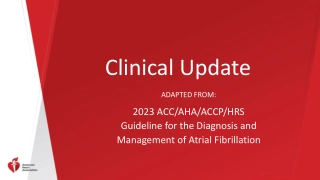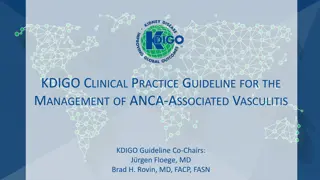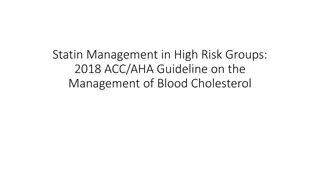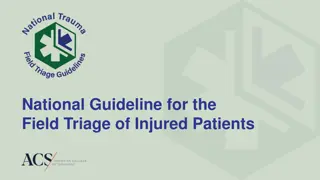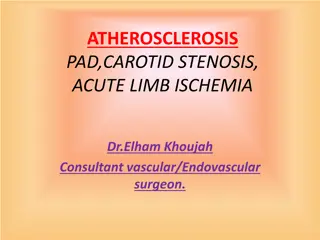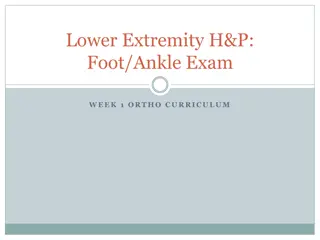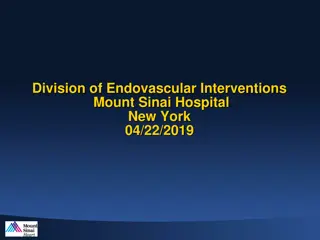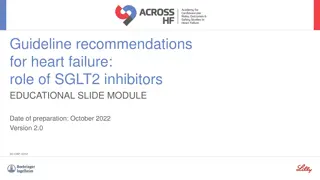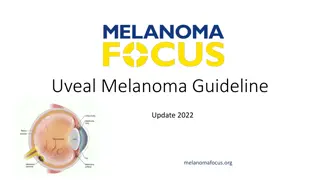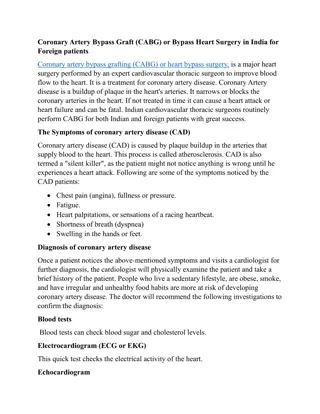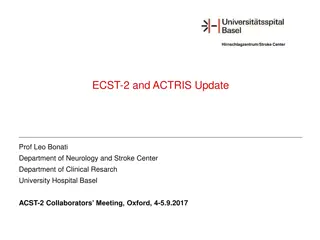2024 AHA/ACC Guideline on Lower Extremity Peripheral Artery Disease
This clinical update presents the classification of recommendations and levels of evidence for managing lower extremity peripheral artery disease according to the 2024 AHA/ACC guideline. It categorizes recommendations based on strength, based on the level of available evidence, ranging from high-quality randomized controlled trials to expert opinion. Recommendations are outlined for different classes, levels of evidence, and compare the benefits versus risks associated with each recommendation. The guideline emphasizes the importance of evidence-based practices in patient care.
Download Presentation

Please find below an Image/Link to download the presentation.
The content on the website is provided AS IS for your information and personal use only. It may not be sold, licensed, or shared on other websites without obtaining consent from the author.If you encounter any issues during the download, it is possible that the publisher has removed the file from their server.
You are allowed to download the files provided on this website for personal or commercial use, subject to the condition that they are used lawfully. All files are the property of their respective owners.
The content on the website is provided AS IS for your information and personal use only. It may not be sold, licensed, or shared on other websites without obtaining consent from the author.
E N D
Presentation Transcript
AHA Clinical Update ADAPTED FROM: 2024 AHA/ACC Guideline on the Management of Lower Extremity Peripheral Artery Disease
CLASS (STRENGTH) OF RECOMMENDATION LEVEL (QUALITY) OF EVIDENCE Table 1. Applying Class of Recommendation and Level of Evidence to Clinical Strategies, Interventions, Treatments, or Diagnostic Testing in Patient Care CLASS 1 (STRONG) Benefit >>> Risk LEVEL A High-quality evidence from more than 1 RCT Meta-analyses of high-quality RCTs One or more RCTs corroborated by high-quality registry studies Suggested phrases for writing recommendations: Is recommended Is indicated/useful/effective/beneficial Should be performed/administered/other Comparative-Effectiveness Phrases : Treatment/strategy A is recommended/indicated in preference to treatment B Treatment A should be chosen over treatment B LEVEL B-R (Randomized) Moderate-quality evidence from 1 or more RCTs Meta-analyses of moderate-quality RCTs LEVEL B-NR (Nonrandomized) CLASS 2a (MODERATE) Benefit >> Risk Moderate-quality evidence from 1 or more well-designed, well- executed nonrandomized studies, observational studies, or registry studies Meta-analyses of such studies Suggested phrases for writing recommendations: Is reasonable Can be useful/effective/beneficial Comparative-Effectiveness Phrases : Treatment/strategy A is probably recommended/indicated in preference to treatment B It is reasonable to choose treatment A over treatment B LEVEL C-LD (Limited Data) Randomized or nonrandomized observational or registry studies with limitations of design or execution Meta-analyses of such studies Physiological or mechanistic studies in human subjects CLASS 2b (Weak) Benefit Risk Suggested phrases for writing recommendations: May/might be reasonable May/might be considered Usefulness/effectiveness is unknown/unclear/uncertain or not well- established LEVEL C-EO (Expert Opinion) A recommendation with LOE C does not imply that the recommendation is weak. Many important clinical questions addressed in guidelines do not lend themselves to clinical trials. Although RCTs are unavailable, there may be a very clear clinical consensus that a particular test or therapy is useful or effective. COR and LOE are determined independently (any COR may be paired with any LOE). Consensus of expert opinion based on clinical experience. CLASS 3: No Benefit (MODERATE) Benefit = Risk *The outcome or result of the intervention should be specified (an improved clinical outcome or increased diagnostic accuracy or incremental prognostic information). For comparative-effectiveness recommendation (COR 1 and 2a; LOE A and B only), studies that support the use of comparator verbs should involve direct comparisons of the treatments or strategies being evaluated. Suggested phrases for writing recommendations: Is not recommended Is not indicated/useful/effective/beneficial Should not be performed/administered/other The method of assessing quality is evolving, including the application of standardized, widely-used, and preferably validated evidence grading tools; and for systematic reviews, the incorporation of an Evidence Review Committee. COR indicates Class of Recommendation; EO, expert opinion; LD, limited data; LOE, Level of Evidence; NR, nonrandomized; R, randomized; and RCT, randomized controlled trial. CLASS 3: Harm (STRONG) Risk > Benefit Suggested phrases for writing recommendations: Gornik, H. L., et al. (2024). 2024 AHA/ACC Guideline on the Management of Lower Extremity Peripheral Artery Disease. Circulation. Gornik, H. L., et al. (2024). 2024 AHA/ACC Guideline on the Management of Lower Extremity Peripheral Artery Disease. Circulation. Potentially harmful Causes harm Associated with excess morbidity/mortality Should not be performed/administered/other
Definitions TERM DEFINITION Acute (<2 week) hypoperfusion of the limb that may be characterized by the following features: pain, pallor, pulselessness, poikilothermia, paresthesias, and/or paralysis. Acute limb ischemia (ALI) A condition characterized by chronic (>2 wk.) ischemic rest pain, nonhealing wounds/ulcers, or gangrene attributable to objectively proven arterial occlusive disease.Current nomenclature has evolved from the prior commonly used term of critical limb ischemia (CLI) to reflect the chronic nature of this condition and its potentially limb-threatening nature with associated risk for amputation and to distinguish it from acute limb ischemia (ALI). Chronic limb-threatening ischemia (CLTI) Major adverse cardiovascular events (MACE) Variably defined but usually includes death (all-cause or cardiovascular), myocardial infarction, acute coronary syndrome (acute MI, unstable angina), and stroke. May also include heart failure, rehospitalization for cardiovascular causes, and other cardiovascular endpoints. Major adverse limb events (MALE) Variably defined but usually includes major amputation and endovascular or surgical lower extremity revascularization (initial or reintervention). May also include ALI. Gornik, H. L., et al. (2024). 2024 AHA/ACC Guideline on the Management of Lower Extremity Peripheral Artery Disease. Circulation. 3
Recognizing Clinical Subsets of PAD Abbreviations: ALI indicates acute limb ischemia; CLTI, chronic limb-threatening ischemia; and PAD, peripheral artery disease. Gornik, H. L., et al. (2024). 2024 AHA/ACC Guideline on the Management of Lower Extremity Peripheral Artery Disease. Circulation. 4
History and Physical Exam for PAD HISTORY PHYSICAL EXAM Claudication Pain type: Aching, burning, cramping, discomfort, or fatigue Location: Buttock, thigh, calf, or ankle Abnormal lower extremity pulse palpation (femoral, popliteal, dorsalis pedis, or posterior tibial arteries) Vascular bruit Onset/offset: Distance, exercise, uphill, how long for relief after rest (typically <10 min for typical claudication) Nonhealing lower extremity wound Lower extremity gangrene Other non-joint-related exertional lower extremity symptoms (not typical of claudication) or symptoms of impaired walking function Lower extremity muscular discomfort associated with walking that requires >10 min rest to resolve Other physical findings suggestive of ischemia like asymmetric hair growth, nail bed changes, calf muscle atrophy, or elevation pallor/dependent rubor. Leg weakness, numbness, or fatigue during walking without pain Ischemic rest pain History of nonhealing or slow-healing lower extremity wound Erectile dysfunction Abbreviations: PAD indicates peripheral artery disease; and min, minute Gornik, H. L., et al. (2024). 2024 AHA/ACC Guideline on the Management of Lower Extremity Peripheral Artery Disease. Circulation. 5
Resting ABI Patients not at increased risk of PAD and without history or physical examination findings suggestive of PAD History or physical examination findings suggestive of PAD Patients at increased risk of PAD Screening for PAD with resting ABI with or without ankle PVR and/or Doppler waveforms is reasonable. (Class 2a) Resting ABI with or without ankle PVR and/or Doppler waveforms (Class 1) Screening for PAD with the ABI is not recommended. (Class 3: No Benefit) Resting ABI should be reported as abnormal, borderline, normal, or non-compressible (Class 1) Abnormal: ABI 0.90 Borderline: ABI 0.91 0.99 Normal: ABI 1.00 1.40 Non-compressible: ABI >1.40 Abbreviations: ABI indicates ankle-brachial index; CLTI, chronic limb-threatening ischemia; PAD, peripheral artery disease; PVR, pulse volume recordings; SPP, skin perfusion pressure; TBI, toe-brachial index; and TcPO2, transcutaneous oxygen pressure. Gornik, H. L., et al. (2024). 2024 AHA/ACC Guideline on the Management of Lower Extremity Peripheral Artery Disease. Circulation. 6
Exercise ABI and Additional Physiological Testing Patients with suspected chronic symptomatic PAD Patients with chronic symptomatic PAD CLTI with Patients with suspected PAD Patients with PAD Suspected CLTI nonhealing wounds or gangrene Segmental leg pressures with PVR and/or Doppler waveforms is reasonable to perform in addition to resting ABI to help delineate anatomic level of PAD (Class 2a) Toe pressure/TBI with waveforms, TcPO2, SPP, and/or other local perfusion measures to determine likelihood of wound healing without or after revascularization (Class 2a) Normal or Non-compressible Resting ABI Abnormal Resting ABI Toe pressure/TBI with waveforms, TcPO2, and/or SPP is reasonable to perform in addition to resting ABI to establish the diagnosis of CLTI (Class 2a) Borderline Resting ABI Exercise treadmill ABI testing to evaluate for PAD (Class 1) TBI with waveforms (Class 1) Exercise treadmill ABI testing to assess functional status and walking performance (Class 2a) Abbreviations: ABI indicates ankle-brachial index; CLTI, chronic. limb-threatening ischemia; PAD, peripheral artery disease; PVR, pulse volume recordings; SPP, skin perfusion pressure; TBI, toe-brachial index; and TcPO2, transcutaneous oxygen pressure. Gornik, H. L., et al. (2024). 2024 AHA/ACC Guideline on the Management of Lower Extremity Peripheral Artery Disease. Circulation. 7
Imaging for PAD Anatomic Assessment (Class 1) Duplex ultrasound Computed tomography angiography Magnetic resonance angiography Catheter angiography Functional limiting claudication despite GDMT Revascularization planning Patients with CLTI To determine revascularization strategy Imaging to establish diagnosis (Class 2b) Duplex ultrasound Computed tomography angiography Magnetic resonance angiography Suspected PAD with inconclusive ABI and physiological testing Invasive or noninvasive imaging should not be performed solely for anatomic assessment (Class 3: Harm) Confirmed diagnosis of PAD in whom revascularization is not being considered Abbreviations: CLTI indicates chronic. limb-threatening ischemia; CTA, computed tomography angiography; GDMT, guideline-directed medical therapy; MRA, magnetic resonance angiography; and PAD, peripheral artery disease. Gornik, H. L., et al. (2024). 2024 AHA/ACC Guideline on the Management of Lower Extremity Peripheral Artery Disease. Circulation. 8
PAD-Related Risk Amplifiers and Health Disparities Increase Risk of MACE and MALE PAD Risk Amplifiers Health Disparities Contributors Older Age (e.g., > 75 years) and Geriatric Syndromes (e.g., frailty, mobility impairment) Geography (i.e., rural location with less access to health care) Diabetes Race and Ethnicity (especially Black, Hispanic, American Indian individuals) Ongoing Smoking and Other Tobacco Use Structural Racism and Implicit Bias Chronic Kidney Disease and End-Stage Kidney Disease Social Determinants of Health Polyvascular Disease (i.e., coexisting atherosclerotic heart-brain-leg cardiovascular disease) Microvascular Disease (retinopathy, neuropathy, nephropathy) Depression Chronic Stress Lower Quality Education and Poor Health Literacy Lower Income and Less Access to Quality Housing Limited Access to Quality Food and Exercise Inadequate Health Insurance Poor Access to Health Care (preventative care, diagnosis, treatment, revascularizations) Impact of Health on Jobs/Workplace Social Determinants of Health Abbreviations: PAD indicates peripheral artery disease; MACE, major adverse cardiovascular events; and MALE, major adverse limb events. Gornik, H. L., et al. (2024). 2024 AHA/ACC Guideline on the Management of Lower Extremity Peripheral Artery Disease. Circulation. 9
Consideration for PAD in Older Patients In older patients with PAD (i.e., age 75 years), assessment for geriatric syndromes can be useful to identify high-risk patients, including before revascularization, and to provide safe and goal-concordant care. (Class 2a) Frailty Impact of amputation Sarcopenia Mobility impairment Malnutrition Revascularization considerations Polypharmacy Encourage shared decision making to evaluate the utility of endovascular, surgical, or hybrid revascularization procedures to balance risk of complications or loss of independence against the potential for improved quality- of-life and palliation of symptoms with a limited life span. Abbreviations: PAD indicates peripheral artery disease. Gornik, H. L., et al. (2024). 2024 AHA/ACC Guideline on the Management of Lower Extremity Peripheral Artery Disease. Circulation. 10
Overview of Medical Therapy and Preventive Footcare for Patients with PAD Medications for Leg Symptoms Diabetes Management Structured Exercise Lipid-Lowering Therapy Program Medical Therapy of PAD Preventive Foot Care Antihypertensive Therapy Antiplatelet and Antithrombotic Therapy Smoking Cessation Abbreviations: PAD indicates peripheral artery disease. Gornik, H. L., et al. (2024). 2024 AHA/ACC Guideline on the Management of Lower Extremity Peripheral Artery Disease. Circulation. 11
Anti-platelet therapy in Patients with PAD Asymptomatic PAD Revascularized PAD COR RECOMMENDATIONS COR RECOMMENDATIONS Single antiplatelet therapy is reasonable to reduce the risk of MACE Endovascular or surgical: antiplatelet therapy is recommended. 2a 1 1 Endovascular or surgical: rivaroxaban (not caps) 2.5 mg BID + low dose aspirin is recommended to reduce risk of MACE and MALE Endovascular: DAPT with P2Y12 antagonist and low dose aspirin for 1-6 months is reasonable 2a Symptomatic PAD If on full-intensity anticoagulation for other indication and are not at a high risk of bleeding, adding single antiplatelet therapy is reasonable COR RECOMMENDATIONS 2a Single agent antiplatelet therapy with aspirin alone (75-325 mg) or clopidogrel alone is recommended 1 If post prosthetic graft, DAPT with P2Y12 antagonist & low dose aspirin for at least one month may be reasonable 2b Rivaroxaban 2.5 mg BID + low dose aspirin is recommended 1 ALL PAD DAPT without recent revascularization in symptomatic PAD has uncertain benefit 2b COR RECOMMENDATIONS Adding vorapaxar to existing therapy is of uncertain benefit 2b In PAD, without another indication, full intensity oral anticoagulation should not be used to reduce the risk of MACE and MALE 3: Harm Abbreviations: BID indicates twice a day; DAPT, dual anti-platelet therapy; MACE, major adverse cardiac events; MALE, major adverse limb events; P2Y12, purinergic receptor P2Y; PAD, peripheral arterial disease. Gornik, H. L., et al. (2024). 2024 AHA/ACC Guideline on the Management of Lower Extremity Peripheral Artery Disease. Circulation. 12
Medical Therapy in Patients with PAD Lipid Lowering Therapy Smoking Cessation COR RECOMMENDATIONS COR RECOMMENDATIONS Remind patients at every visit to quit or maintain cessation of tobacco use 1 High intensity statin to lower LDL-C by 50% 1 If LDL-C remains 70 mg/dL on maximally tolerated statin, adding ezetimibe or a PCSK9 inhibitor is reasonable Pharmacotherapy should be included in tobacco cessation plans combined with counseling and referral to smoking cessation program 2a 1 1 Advise patients to avoid secondhand smoke exposure Antihypertensive Therapy Diabetes COR RECOMMENDATIONS COR RECOMMENDATIONS Antihypertensive therapy to reduce the risk of MACE 1 Multidisciplinary team approach 1 Glycemic control with GLP1-receptor agonist and SGLT2i to reduce risk of MACE 1 1 SBP goal <130 mmHg DBP goal <80 1 2b Use ACEI or ARBs to reduce the risk of MACE Glycemic control may be beneficial to improve limb outcomes Abbreviations: ACEI indicates angiotensin converting enzyme inhibitor; ARB, angiotensin II receptor blocker; DBP, diastolic blood pressure; GLP1-a, glucagon-like peptide-1 agonist; LDL, low-density lipoprotein; MACE, major adverse limb events; mmHg, millimeters of mercury; PCSK9i, proprotein convertase subtilsin-kexin type 9; PAD, peripheral artery diseases; SBP, systolic blook pressure; and SGLT2i, sodium-glucose transporter 2 inhibitor. Gornik, H. L., et al. (2024). 2024 AHA/ACC Guideline on the Management of Lower Extremity Peripheral Artery Disease. Circulation. 13
Preventive Foot Care and Leg Symptom Management in Patients with PAD Leg Symptoms Preventive Foot Care COR RECOMMENDATIONS COR RECOMMENDATIONS Cilostazol is recommended to increase walking distance and reduce symptoms 1 Educating patients & family on preventive foot care 1 1 Foot inspection by clinician at every visit Cilostazol may help reduce restenosis after endovascular therapy in femoropopliteal disease 2b Therapeutic footwear for those at high risk for ulcers/amputation 1 3: No Benefit In chronic symptomatic PAD pentoxifylline and chelation therapy are not recommended for treatment of claudication. Comprehensive foot evaluation annually to identify risk factors for ulcers and amputation 1 In patients with PAD and congestive heart failure cilostazol is not recommended Referral to a foot care specialist for preventive care and longitudinal surveillance is reasonable 3: Harm 2a Abbreviations: PAD indicates peripheral artery disease. Gornik, H. L., et al. (2024). 2024 AHA/ACC Guideline on the Management of Lower Extremity Peripheral Artery Disease. Circulation. 14
Exercise Therapy for Patients with PAD Post revascularization for chronic symptomatic PAD Chronic symptomatic PAD COR RECOMMENDATIONS COR RECOMMENDATIONS 1 Supervised exercise therapy is effective 1 Supervised exercise therapy is recommended A structured community-based program with behavioral change techniques is effective 1 Functionally limiting claudication Non-walking structured exercise programs can be beneficial COR RECOMMENDATIONS 2a Supervised exercise therapy or structured community-based exercise therapy should be the initial treatment option 1 Usefulness of unstructured exercise programs is uncertain 2b Abbreviations: PAD indicates peripheral artery disease. Gornik, H. L., et al. (2024). 2024 AHA/ACC Guideline on the Management of Lower Extremity Peripheral Artery Disease. Circulation. 15
Revascularization for Asymptomatic PAD COR RECOMMENDATIONS In patients with asymptomatic PAD, it is reasonable to perform procedures to reconstruct diseased arteries if neededfor the safety, feasibility, or effectiveness of other procedures. 2a In patients with asymptomatic PAD, revascularization should NOT be performed to prevent the progression of disease. 3: Harm Abbreviations: PAD indicates peripheral artery disease. Gornik, H. L., et al. (2024). 2024 AHA/ACC Guideline on the Management of Lower Extremity Peripheral Artery Disease. Circulation. 16
Patient-centered Approach to Revascularization Start GDMT and assess response Revascularization consideration Patient-centered discussion Clinical presentation Functionally limiting claudication despite GDMT Severity of symptoms Hemodynamically significant PAD Functional status History and physical Anticipated natural history Walking performance Physiological testing Degree of functional limitation Imaging studies Response to GDMT (including structured exercise) thus far Quality-of-life Revascularization strategy Likelihood of short and long-term benefit Potential short and long-term procedural risk Abbreviations: GDMT indicates guideline-directed management and therapy. Gornik, H. L., et al. (2024). 2024 AHA/ACC Guideline on the Management of Lower Extremity Peripheral Artery Disease. Circulation. 17
Algorithm for Revascularization for Claudication, Chronic Symptomatic PAD Revascularization not recommended (3: No benefit) Symptoms are functionally limiting and response to GDMT (including structured exercise) is inadequate? No No Revascularization is a reasonable treatment option (2a) Risk/benefit assessment: do potential benefits of revascularization (QOL, walking performance, functional status) outweigh risks? (1) Yes Yes Hemodynamically significant aortoiliac or femoropopliteal disease Hemodynamically significant common femoral artery disease Hemodynamically significant isolated infrapopliteal disease Effectiveness of endovascular revascularization is unknown (2b) Effectiveness of surgical revascularization is unknown (2b) Surgical revascularization is reasonable if perioperative risk is acceptable and technical factors suggest advantages of endovascular approaches (2a) Endovascular revascularization is effective (1) Endarterectomy is reasonable, particularly to preserve profunda femoris artery pathways (2a) Endovascular approaches may be considered if patient is high risk for surgery and/or anatomic factors are favorable (2b) Continue GDMT including structured exercise (1) Fem-pop bypass autogenous vein preferred (1) Abbreviations: GDMT indicates guideline-directed management and therapy; PAD, peripheral artery disease; and QOL, quality of life. Gornik, H. L., et al. (2024). 2024 AHA/ACC Guideline on the Management of Lower Extremity Peripheral Artery Disease. Circulation. 18
Revascularization for Functionally Limiting Claudication, Recommendations based on Location of Disease Aortoiliac Femoropopliteal COR RECOMMENDATIONS COR RECOMMENDATIONS 1 1 Endovascular revascularization is effective Endovascular revascularization is effective Surgical revascularization is reasonable based on perioperative risk and technical factors Surgical revascularization is reasonable based on perioperative risk and technical factors 2a 2a Common Femoral Infrapopliteal COR RECOMMENDATIONS COR RECOMMENDATIONS Effectiveness of both endovascular and surgical revascularization is unknown 2a Surgical endarterectomy is reasonable 2b Endovascular approach may be considered based on surgical risk and anatomical factors. 2b Note: Patients should have functionally limited claudication and inadequate response to GDMT (including structured exercise) to be considered for revascularization. Abbreviations: GDMT indicates guideline-directed management and therapy. Gornik, H. L., et al. (2024). 2024 AHA/ACC Guideline on the Management of Lower Extremity Peripheral Artery Disease. Circulation. 19
Conduit for Surgical Revascularization for Femoropopliteal Disease Functionally limiting claudication Significant femoropopliteal disease Surgical revascularization planned Autogenous vein preferred to prosthetic graft material (Class 1) Gornik, H. L., et al. (2024). 2024 AHA/ACC Guideline on the Management of Lower Extremity Peripheral Artery Disease. Circulation. 20
Components of Care for CLTI Selective amputation (most distal level possible) Wound care and management of infection Multispecialty care team Antiplatelet/ antithrombotic therapy and cardiovascular risk reduction Revascularization (endovascular, surgical, hybrid) Pressure offloading Abbreviations: CLTI indicates chronic limb threatening ischemia. Gornik, H. L., et al. (2024). 2024 AHA/ACC Guideline on the Management of Lower Extremity Peripheral Artery Disease. Circulation. 21
Revascularization Goals for CLTI COR RECOMMENDATIONS In patients with CLTI, surgical, endovascular, or hybrid revascularization techniques are recommended, when feasible, to minimize tissue loss, heal wounds, relieve pain, and preserve a functional limb. 1 In patients with CLTI, an evaluation for revascularization options by a multispecialty care team is recommended before amputation. 1 Abbreviations: CLTI indicates chronic limb threatening ischemia. Gornik, H. L., et al. (2024). 2024 AHA/ACC Guideline on the Management of Lower Extremity Peripheral Artery Disease. Circulation. 22
Revascularization Strategy for CLTI COR RECOMMENDATIONS In patients undergoing surgical revascularization for CLTI, bypass to the popliteal or infrapopliteal arteries should be constructed with autogenous vein if available. 1 In patients with CLTI due to infrainguinal disease, anatomy, available conduit, patient comorbidities, and patient preferences should be considered in selecting the optimal first revascularization strategy (surgical bypass or endovascular revascularization). 1 In patients with CLTI who are candidates for surgical bypass and endovascular revascularization, ultrasound mapping of the great saphenous vein is recommended. 1 Abbreviations: CLTI indicates chronic limb threatening ischemia. Gornik, H. L., et al. (2024). 2024 AHA/ACC Guideline on the Management of Lower Extremity Peripheral Artery Disease. Circulation. 23
Revascularization Strategy for CLTI-continued COR RECOMMENDATIONS In patients with CLTI for whom a surgical approach is selected and a suitable autogenous vein is not available, alternative conduits such as prosthetic or cadaveric grafts can be effective for bypass to the popliteal and tibial arteries. 2a In patients with CLTI and nonhealing wounds or gangrene, revascularization in a manner that achieves in-line blood flow or maximizes perfusion to the wound bed can be beneficial. 2a In patients with CLTI with ischemic rest pain attributable to multilevel arterial disease, a revascularization strategy addressing inflow disease first is reasonable. 2a Abbreviations: CLTI indicates chronic limb threatening ischemia. Gornik, H. L., et al. (2024). 2024 AHA/ACC Guideline on the Management of Lower Extremity Peripheral Artery Disease. Circulation. 24
Minimizing Tissue Loss for CLTI: Pressure offloading is key COR RECOMMENDATIONS Patients with CLTI and diabetic foot ulcers should receive pressure offloading, when possible, to promote tissue growth and wound healing. 1 Patients with PAD and prior diabetic foot ulcers should be referred for customized footwear that accommodates, protects, and fits the shape of their feet. 1 Patients with CLTI and foot ulcers who do not have diabetes may be considered for pressure offloading to promote tissue growth and wound healing. 2b Abbreviations: CLTI indicates chronic limb threatening ischemia; and PAD, peripheral artery disease. Gornik, H. L., et al. (2024). 2024 AHA/ACC Guideline on the Management of Lower Extremity Peripheral Artery Disease. Circulation. 25
Wound Care and Infection for Patients with CLTI COR RECOMMENDATIONS Prompt management of foot infection with antibiotics, debridement, and other surgical management is recommended. 1 With nonhealing wounds, wound care should be provided to optimize the wound healing environment after revascularization with the goal of complete wound healing. 1 In nonhealing diabetic foot ulcers, hyperbaric oxygen therapy may be considered to assist in wound healing after revascularization. 2b Abbreviations: CLTI indicates chronic limb threatening ischemia. Gornik, H. L., et al. (2024). 2024 AHA/ACC Guideline on the Management of Lower Extremity Peripheral Artery Disease. Circulation. 26
No Option Patients In patients with CLTI for whom revascularization is not an option: COR RECOMMENDATIONS Usefulness of prostanoids is uncertain. 2b Arterial intermittent pneumatic compression devices may be considered to augment wound healing or ameliorate ischemic rest pain. 2b Venous arterialization may be considered for limb preservation if a lack of outflow to the foot is observed 2b Abbreviations: CLTI indicates chronic limb threatening ischemia. Gornik, H. L., et al. (2024). 2024 AHA/ACC Guideline on the Management of Lower Extremity Peripheral Artery Disease. Circulation. 27
Amputation in Patients with CLTI COR RECOMMENDATIONS For those who require amputation, evaluation should be performed by a multispecialty care team to assess for the most distal level of amputation that facilitates healing and provides maximal functional ability 1 Primary amputation is indicated when life over limb is the prevailing consideration and clinical factors suggest the threatened limb to be the cause of the patient s instability 1 A patient-centered approach using objective classification of the threatened limb, patient risk, and anatomic pattern of disease is combined with patient and family goals is recommended to identify those patients in whom primary amputation or palliative management is appropriate 1 When undergoing a minor amputation, a customized program of follow-up care that can include local wound care, pressure offloading, serial evaluation of foot biomechanics and use of therapeutic footwear is recommended to prevent wound recurrence 1 Retrospective assessment of institutional outcomes with objective limb threat classification tools can be useful for quality improvement 2a Abbreviations: CLTI indicates chronic limb threatening ischemia. Gornik, H. L., et al. (2024). 2024 AHA/ACC Guideline on the Management of Lower Extremity Peripheral Artery Disease. Circulation. 28
ALI Diagnosis and Management Suspected ALI All Patients With ALI Acutely cold, painful, pulseless leg (symptoms <14 days) Heparin unless contraindicated (1) Comprehensive history/ physical examination Assess for underlying cause (2a) Suspected ALI Testing for acute CV cause (EKG, echocardiography, heart rhythm monitoring) (2a) Emergency clinical evaluation including: symptoms, motor and sensory assessment, arterial and venous Doppler signals (1) Abbreviations: ALI indicates acute limb ischemia; CV, cardiovascular; and EKG, electrocardiogram. Gornik, H. L., et al. (2024). 2024 AHA/ACC Guideline on the Management of Lower Extremity Peripheral Artery Disease. Circulation. 29
ALI Diagnosis and Management Management Based on Clinical Assessment and Doppler Signals Emergency clinical evaluation including symptoms, motor and sensory assessment, arterial and venous Doppler signals (1) Suspected ALI Inaudible arterial / Audible venous Audible arterial / Audible venous Inaudible arterial / Inaudible venous Category III: Irreversible Complete loss of motor function Complete sensory loss Category I: Viable Normal motor function No sensory loss Motor function assessment Category IIa: Marginally threatened Sensory loss limited to toes if present No muscle weakness Category IIb: Immediately threatened Sensory loss more than toes Mild or moderate muscle weakness Revascularization (urgent) AND anticoagulation with heparin, unless contraindicated (1) Revascularization should not be performed (i.e. primary amputation of non-viable tissue is indicated) (3: Harm) Salvageable if treated emergently Salvageable if treated urgently Monitor/treat for compartment syndrome (fasciotomy) (1) Revascularization (urgent Category IIa/emergency Category IIb) AND anticoagulation with heparin, unless contraindicated (1) Concurrent/early amputation if prolonged ischemia (2a) Monitor/treat for compartment syndrome (fasciotomy) (1) Prophylactic fasciotomy (2a) Abbreviations: ALI indicates acute limb ischemia. Gornik, H. L., et al. (2024). 2024 AHA/ACC Guideline on the Management of Lower Extremity Peripheral Artery Disease. Circulation. 30
Revascularization for ALI Revascularization COR RECOMMENDATIONS In patients with ALI and a salvageable limb, revascularization (endovascular or surgical, including catheter-directed thrombolysis) is indicated to prevent amputation. 1 In patients with ALI and a salvageable limb who are treated with catheter-directed thrombolysis, adjunctive revascularization (i.e., endovascular or surgical) procedures can be useful. 2a In patients presenting with ALI from chemotherapeutic or prothrombotic viral states, it may be reasonable to take a more deliberate planning strategy before engaging in a definitive revascularization or medical treatment plan. 2b 3: Harm In patients with ALI with a nonsalvageable limb, revascularization of nonviable tissue should not be performed. Abbreviations: ALI indicates acute limb ischemia. Gornik, H. L., et al. (2024). 2024 AHA/ACC Guideline on the Management of Lower Extremity Peripheral Artery Disease. Circulation. 31
Acute Limb Ischemia Minimizing Tissue Loss Establishing Etiology COR RECOMMENDATIONS COR RECOMMENDATIONS Patients with ALI should be monitored and treated for compartment syndrome with fasciotomy after revascularization to prevent reperfusion injury and need for amputation. History and physical examination should be performed to determine the cause of thrombosis or embolization. 1 1 In patients with ALI with a threatened but salvageable limb, prophylactic fasciotomy is reasonable. 2a Testing for a cardiovascular cause of thromboembolism can be useful. 2a In patients with ALI and prolonged ischemia in whom revascularization is performed, concurrent and early amputation can be beneficial to avoid morbidity of reperfusion. 2a Abbreviations: ALI indicates acute limb ischemia. Gornik, H. L., et al. (2024). 2024 AHA/ACC Guideline on the Management of Lower Extremity Peripheral Artery Disease. Circulation. 32
Longitudinal Follow-Up of Patients with PAD COR RECOMMENDATIONS COR RECOMMENDATIONS After infrainguinal, autogenous vein bypass graft(s) without new lower extremity signs or symptoms, it is reasonable to perform ABI and arterial duplex ultrasound surveillance within the first 1 to 3 months post procedure, then repeat at 6 and 12 months, and then annually. With or without revascularization, routine clinical evaluation, including assessment of limb symptoms and functional status, lower extremity pulse and foot assessment, and progress of risk factor management is recommended. 1 2a Coordination among specialists to improve management and outcomes. 1 After endovascular procedures without new lower extremity signs or symptoms, it is reasonable to perform ABI and arterial duplex ultrasound surveillance within the first 1 to 3 months post procedure, then repeat at 6 and 12 months, and then annually. With or without revascularization, periodic assessment of functional status and health-related QOL. 1 2a Long-term use of GDMT to prevent MACE and MALE is recommended. 1 After infrainguinal, prosthetic bypass graft(s) without new lower extremity signs or symptoms, the effectiveness of ABI and arterial duplex ultrasound surveillance is uncertain. After lower extremity revascularization include periodic clinical evaluation of lower extremity symptoms and pulse and foot assessment is recommended. 2b 1 Telehealth can be used for vascular evaluation and management and longitudinal follow-up, depending on the urgency of presenting symptoms. After lower extremity revascularization with new lower extremity signs or symptoms, ABI and arterial duplex ultrasound is recommended. 2a 1 Abbreviations: ABI indicates ankle-brachial index; GDMT, guideline-directed management and therapy; MACE, major adverse cardiovascular events; MALE, major adverse limb events; PAD, peripheral artery disease; and QOL, quality of life. Gornik, H. L., et al. (2024). 2024 AHA/ACC Guideline on the Management of Lower Extremity Peripheral Artery Disease. Circulation. 33
Evidence Gaps Studies to compare telehealth technology vs. facility-based supervised exercise therapy. Clinical trials in asymptomatic patients Benefit of screening in those at-risk Benefit of medical therapies to prevent MACE and MALE RCT or registry data for chronic symptomatic PAD treated by exercise therapy, endovascular management, and surgical management with hard outcomes, including MACE and MALE. Studies to identify new medical therapies to improve functional status Comparative effectiveness studies of endovascular devices for revascularization of PAD. Studies on patients who have undergone revascularization procedures Determination of optimal antiplatelet and antithrombotic regimen. Studies comparing outcomes of different strategies for revascularization of CLTI (in-line flow, angiosome, would blush). Studies to determine the ideal timing and modality for vascular surveillance testing post-revascularization procedures. Studies on the effect of shared decision-making strategies in the management of chronic symptomatic PAD and CLTI Development of patient-reported metrics of functional status/walking performance for outcome measures of studies of revascularization. Abbreviations: CLTI indicates chronic limb-threatening ischemia; GDMT, guideline-directed management and therapy; MACE, major adverse cardiovascular events; MALE, major adverse limb events; and PAD, peripheral artery disease. Gornik, H. L., et al. (2024). 2024 AHA/ACC Guideline on the Management of Lower Extremity Peripheral Artery Disease. Circulation. 34
Advocacy Priorities Access to Care/Guideline implementation Disparities National Initiatives Address racial disparity gap in amputation, revascularization, and risk modification Collaborative teamwork between all specialties 20% reduction in non-traumatic amputations by 2030 Broad dissemination and implementation of these guidelines with focus on quality outcomes Strategies to improve the use of structured exercise therapy. Creation of national registry of nontraumatic lower extremity amputation to identify opportunities for improvement and to unmask factors associated with disparities in treatment. 2 Telemedicine and remote patient- monitoring devices. Abbreviations: PAD indicates peripheral artery disease. Gornik, H. L., et al. (2024). 2024 AHA/ACC Guideline on the Management of Lower Extremity Peripheral Artery Disease. Circulation. 35
Acknowledgments Many thanks to our Guideline Ambassadors who were guided by Dr. Elliott Antman in developing this translational learning product in support of the 2024 AHA/ACC Guideline on the Management of Lower Extremity Peripheral Artery Disease. Dr. Nicholas Brownell Dr. Trevor Cline Dr. Xing Dai Dr. Eson Ekpo Dr. Prerna Gupta Dr. Joyce Han Dr. Usman Hasnie Dr. Jake Mayfield Dr. Eman Rashed The American Heart Association requests this electronic slide deck be cited as follows: Brownell, N., Cline, T., Dai, X., Ekpo, E., Gupta, P., Han, J., Hasnie, U., Mayfield, J., Rashed, E., Reyna, G., Bezanson, J. L., & Antman, E. M. (2024). AHA Clinical Update; Adapted from: [PowerPoint slides]. Retrieved from the 2024 AHA/ACC Guideline on the Management of Lower Extremity Peripheral Artery Disease. https://professional.heart.org/en/science-news. Gornik, H. L., et al. (2024). 2024 AHA/ACC Guideline on the Management of Lower Extremity Peripheral Artery Disease. Circulation. 36


